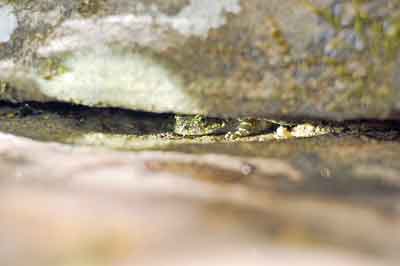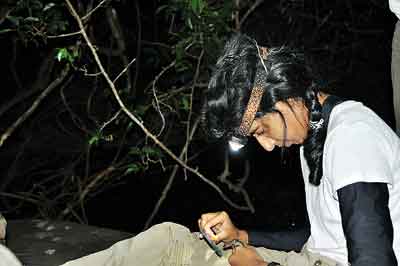Knuckles frog croaks out in alarm
In mist-laden Dumbara, amidst the crevices of the Knuckles mountain range, lives an interesting four-legged friend – about 45 mm in size. The flat-bodied brown and yellow creature is now croaking with alarming news! A study was undertaken on investigating the population dynamics, microhabitat use, and variation in body temperature of this Marbled Rock Frog or Dumbara Galpara Mediya (deriving its name from its habitat) by Uvini Senanayake from the Department of Zoology and Environment Sciences, University of Colombo. She was supervised by Prof. Mayuri Wijesinghe and Prof. Devaka Weerakoon and has unearthed some notable findings. The results of the research which commenced in February 2016 will be published shortly.

Well camouflaged: The Marbled Rock Frog hidden in a crevice
Zoologically termed Nannophrys marmorata, the Marbled Rock Frog is restricted to the Knuckles mountain range between elevations of 200- 1220 m and is found nowhere else. “The genus Nannophrys is an endemic genus and this is the only amphibian in Sri Lanka which has tadpoles that are adapted to live a semi-terrestrial life,” points out Uvini. As she further explains, the genus includes four species in all, three extant (living) species – Nannophrys ceylonensis, Nannophrys marmorata and Nannophrys naeyakai and one extinct species, Nannophrys guentheri. “From among the three extant (living) species, N. marmorata is the only species which has been assigned a ‘Critically Endangered’ status due to its restricted distribution in the Knuckles range.”
The young zoologist whose zest for field-based research which was fuelled by the inspiration received by her mentors Prof. Mayuri Wijesinghe and Prof. Devaka Weerakoon, propelled her to study certain aspects of Nannophrys marmorata which were hitherto unexplored. Although morphological and osteological aspects of the animal had been already established, this is a first-time study of the habitat and population dynamics, as she asserts. “Prof. Wijesinghe had been taking us on field study sessions to Knuckles frequently where we first saw this frog. It was interesting to observe how it survived in this harsh environment, so I was keen to do more research about this critically endangered species for my undergraduate project,” recollects Uvini.

Uvini out in the field
The Pitawala Patana of the Knuckles range, was chosen by Uvini for her research due to the thriving population of the frog species found here and also due to relatively easy accessibility. The research which commenced in February 2016 (at the end of the wet season in which the frog breeds) required ‘night-sampling’ of the frogs found on the rock surfaces to be repeated every two months, and entailed the recording of the tadpoles, eggs, body temperature and the temperatures of the crevices and the outside environment. The sampling, which was a tedious exercise as Uvini explains, was done from 6 p.m. to 10 p.m., the peak period of frog activity. These frogs live in narrow rock crevices next to clear water streams and come out on to rock surfaces at night to feed.
A prime reason which renders the frog to be restricted to a small range is its breeding which is confined to the short, wet season from November to February. “With the arrival of the prolonged dry season which lasts for about 8 months, accompanied by strong winds, the number of frogs dwindled restricting its spread,” notes Uvini. Moreover those surviving the harsh dry weather do not generally come out to forage at night. In terms of its distribution, although it is confined to Knuckles, the area of occurrence within the mountain range is yet to be established.
Apart from restricting its expansion, the ‘extreme seasonality’ of the Knuckles range has a huge bearing on the well being of the species, notes Prof. Mayuri Wijesinghe. A distinctive feature of the Marbled Rock Frog is its ability to fit into extremely narrow crevices and remain well camouflaged. The frog’s adaptability to living in rock crevices, despite the ‘chilly’ nature of the interiors, is remarkable. This frog’s body temperature, as Prof. Wijesinghe explains, reflects more the crevice temperature than the outside temperature.

Prof. Mayuri Wijesinghe
Despite this adaptation, the long term survival of the frog in the face of climate change may be in doubt. The climatic changes coupled with human activity such as illegal clearance and intentional fires have become issues of concern for the survival of this ‘Dumbara dweller’. Montane habitats are particularly threatened due to fragmentation and forest loss. Moreover, impacts of climate change are predicted to be more severe in montane regions. In case of Pitawala patana, it is a site of visitor attraction with a nature trail to the ‘Mini World’s End’ falling across the plain. “During the wet season, large numbers of the semi-terrestrial tadpoles are found on exposed rock surfaces and are unwittingly trampled by those travelling to the Mini World’s End. The school vacation in December, which coincides with the frog’s breeding season, further aggravates the situation,” reflects Prof. Wijesinghe.
Divisional Forest Officer of Illukumbura, H. M. A. B. Herath, has already been receptive to their proposal to relocate the section of the nature trail which traverses the frog habitats. Measures to enhance public awareness such as erecting boards proclaiming the importance of the frog in terms of conservation value are also underway.
Recollecting the challenges which had to be braved during the research, Uvini reflects, “the change in air temperature was drastic – during the dry season, the day temperature could go up to about 41oC and at night it could plunge to about 18 o C. “Monitoring the body temperature of the frogs every two hours throughout the day and night in harsh weather was challenging, and in addition we had to be vigilant knowing that elephants come to the Knuckles range at certain times of the year.” Yet she is quick to add that the whole experience was just enriching, and she has already presented her research findings at the Student conference on Conservation Science 2017 in Bangalore. Applauding her promising student for a job well done despite many constraints Prof. Wijesinghe says that a few more research papers are in the pipeline.


